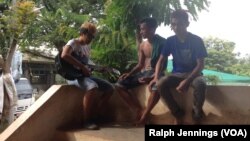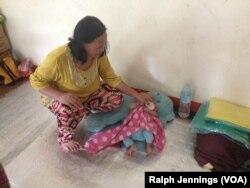Increasingly impatient people from a war-razed city in the Muslim region of the Philippines expect reconstruction to take at least five years, despite pledges for quick recovery, after a Chinese-backed building consortium failed to get a building contract.
Many among the 27,000 families officially listed as "internally displaced people" by the 2017 war between troops and a group of Muslim separatists said this week they’re ready to live indefinitely in single-room units built with relief money. They lost their own houses and small businesses when firefights last year wrecked a quadrant of their hilly lakeside city, Marawi.
If recovery drags on, refugees may lose patience, playing into the hands of rebel groups such as the one that sparked last year’s civil war, one scholar in Marawi said.
In November the National Disaster Risk Reduction and Management Council executive director said Marawi would be rebuilt "as fast as we can." In May presidential spokesman Harry Roque "assured the public that the government is acting fast."
But a building consortium backed by investors from China and Malaysia was disqualified in June for a bid to rebuild Marawi’s war zone for lack of available capital. That job will cost 17 billion to 20 billion pesos ($319 million-$375 million), said Asec Felix Castro, field office manager with a government housing coordination agency in charge of Marawi.
"Unfortunately, the negotiation with the first developer failed so we’re talking with the number two developers," Castro said.
Surge in temporary housing
Cairona Alonto, 60, has lived since February in a single-room, prefab unit in a barren refugee camp on the outskirts of Marawi. The government paid for her unit, but she had lost a four-room house and her dress shop to the fighting. Troops razed houses as they suspected rebel snipers were taking shelter there.
"Right now, we are still adjusting (to) the environment," said Alonto, who now shares the unit with her aging mother. "It’s different from our past. You look at our house, very small. There is no proper way of comfort and it’s really hard for our small place."
Lack of a reconstruction schedule has given rise to 3,000 one-room, temporary housing units and 3,000 more permanent ones with more on the way, a National Housing Authority official in Marawi said. More refugees live in a Marawi tent city, and still others live in camps outside town.
Money from China, Japan and Taiwan has helped the Philippine government build the temporary housing. Vehicles at a temporary housing site show the name of a Japanese corporate donor. The Taiwan government and the Taiwanese charity Tzu Chi Foundation broke ground this month on 400 more prefab homes.
The war started in May last year when separatists called the Maute Group joined hands with a more established, IS-backed group and tried to take over central Marawi. About 1,100 people, mostly rebels, died in the five-month war that extended the surrounding island of Mindanao’s decades-old struggle between Muslim separatists and the Philippine government.
Doubts about government resolve Internally displaced people, or IDPs, say they are angry that reconstruction will take longer than expected. Some have prepared to stay the legal maximum five years in the temporary units -- longer if allowed.
Some people are living five or six people per unit, often on the floor for lack of furniture.
"Most of the misplaced IDPs are so sad about that," said Monara Maruhom, assistant dean of the King Faisal Center for Islamic, Arabic and Asian Studies at Mindanao State University in Marawi."IDPs are really congested inside the very little temporary shelter with a kitchen and everything. Their condition is not healthy."
Mounting impatience could turn displaced people against the government a point where they sympathize with Muslim separatist groups, she said.
About 20 such groups exist in Mindanao and its offshore islands, drawing support from Muslims who believe the largely Christian nation has deprived it of resources.
Reconstruction timeline
The rejected contractor backed by Chinese money had "many liabilities" and a poor "record" including unfinished projects elsewhere, Maruhom said.
But it’s not clear when a new contractor will be picked, and Marawi dwellers – largely poor or lower-middle class small business owners -- say there’s no guarantee the government will pay to rebuild the private houses that were destroyed.
Once the government finds another contractor, it should take six to 12 months to clear the war-torn structures, Castro said. The contractor would later rebuild roads and utility lines, he said.
Reconstruction is taking time because the government consults local people about its plans, Castro added. Those talks can get bogged down in confusion over land rights, he said. “Because of the enormity of the problem, the project, there were all sorts of consultations,” Castro said.








